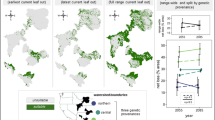Abstract
Data from a short-term provenancetrial of black spruce (Picea mariana (Mill.)B.S.P.) were used to illustrate a methodology to helplocate breeding zone boundaries using adaptivevariation models. Four height growth and survivalvariables were summarized by principal componentsanalysis (PCA), and the first three axis scores wereregressed against climate data determined from arecently developed Ontario Climate Model. Theregression equations were used to model the PCA axes,and these models were interpreted as the three maincomponents of adaptive variation in the data. Thesemodels were converted to geographic grids using GISsoftware. In a manner similar to that proposed fordifferential systematics applications, theDifferential Systematic Coefficient (DSC) was adaptedto be an indicator of the weighted average rate ofchange of clinally expressed adaptive variation overdistance. An output grid was determined based on theDSC values, such that grid cells with highercoefficient values were made to appear darker on theresultant map; thus, the shaded areas corresponded tosteeper portions of the clines of adaptive variationand serve as desirable indicators of the bestlocations for breeding zone boundaries.
Similar content being viewed by others
References
Adams, R. P. 1970. Contour mapping and differential systematics of geographic variation. Syst. Zool. 19: 385-390.
Barbujani, G., Oden, N. L. and Sokal, R. R. 1989. Detecting regions of abrupt change in maps of biological variables. Syst. Zool. 38: 376-389.
Boyle, T. J. B. 1985. Range wide provenance tests of black spruce in Ontario. Can. For. Serv. Petawawa Natl. For. Inst. Inf. Rep. No. PI-X-57, 36 pp.
Boyle, T. J. B. 1986. Ten-year height growth of open-pollinated black spruce families in Ontario. Can. For. Serv. Petawawa Natl. For. Inst. Inf. Rep. No. PI-X-61, 24 pp.
Campbell, R. K. 1986. Mapped genetic variation of Douglas-fir to guide seed transfer in southwest Oregon. Silvae Genet. 35: 85-96.
Environment Systems Research Institute. 1987. Arc/Info user's manual. Redlands, Calif.
Heslop-Harrison, J. 1964. Forty years of genecology. In: Cragg, J. B. (Ed), Advances in Ecological Research 2: 159-247.
Hills, G. A. 1961. The ecological basis for land-use planning. Ont. Dept. Lands and Forests, Res. Dept. No. 46, 204 pp.
Mackey, B. G., McKenney, D. W., Yang, Y.-Q., McMahon, J. P. and Hutchinson, M. F. 1996. Site regions revisited: a climatic analysis of Hills' site regions for the province of Ontario using a parametric method. Can. J. For. Res. 26: 333-354.
Parker, W. H. and van Niejenhuis, A. 1996a. Regression-based focal point seed zones for Picea mariana from northwestern Ontario. Can. J. Bot. 74: 1227-1235.
Parker, W. H. and van Niejenhuis, A. 1996b. Seed zone delineation for jack pine in the former Northwest Region of Ontario using short-term testing and geographic information systems. Nat. Resources Canada, Can. For. Serv., Gr. Lakes For. Centre, Sault Ste. Marie, On. Tech. Rep. NODA/NFP TR-35, 34 pp.
Parker, W. H., van Niejenhuis, A. and Charrette, P. 1994. Adaptive variation in Picea mariana from northwestern Ontario determined by short-term common environment tests. Can. J. For. Res. 24: 1653-1661.
Parker W. H. 1992. Focal point seed zones: site specific delineation by geographic information systems. Can. J. For. Res. 22: 267-271.
Parker, W. H. 1994a. Focal point seed zones of black spruce and jack pine. Zone 2 Edition. Private printing for Ontario Tree Improvement Board, Thunder Bay, 123 pp.
Parker, W. H. 1994b. Focal point seed zones of black spruce and jack pine. Zone 3 Edition. Private printing for Ontario Tree Improvement Board, Thunder Bay, 131 pp.
Raymond, C. A. and Lindgren, D. 1990. Genetic flexibility-a model for determining the range of suitable environments for a seed source. Silv. Gen. 39: 112-120.
Rehfeldt, G.E. 1991. Models of genetic variation for Pinus ponderosa in the Inland Northwest (U.S.A.): applications in gene resource management. Can. J. For. Res. 21: 1491-1500.
Rehfeldt, G. E. 1994. Adaptation of Picea engelmannii populations to the heterogeneous environment of the Intermountain West. Can. J. Bot. 72: 1197-1208.
SAS Institute Inc. 1989. SAS/Stat User's Guide, Version 6, Fourth Ed., SAS Inst. Inc., Cary, N.C.
Sokal, R. R. and Rohlf, F. J. 1981. Biometry 2nd ed. W.H. Freeman & Co. San Francisco.
Westfall, R. D. 1992. Developing seed transfer zones. In: Lins, L, Friedman, S. T. and Brotschol, J. V. (Eds), Handbook of Quantitative Forest Genetics. Kluwer Academic Publishers, Dordrecht, 403 pp.
Westfall, R. D. and Conkle, M. T. 1992. Allozyme markers in breeding zone designation. New For. 6: 279-309.
Whitewood, R. D. and MacIver, D. C. 1991. Forest Climates of Ontario. Part 2: GIS-Generated Climatic Atlas of Ontario. Ont. Min. Natl. Res., Toronto.
Womble, W.H. 1951. Differential systematics. Science 114: 315-322.
Author information
Authors and Affiliations
Rights and permissions
About this article
Cite this article
Parker, W.H. Rates of change of adaptive variation in Picea mariana visualized by GIS using a differential systematic coefficient. New Forests 20, 259–276 (2000). https://doi.org/10.1023/A:1006736019650
Issue Date:
DOI: https://doi.org/10.1023/A:1006736019650




